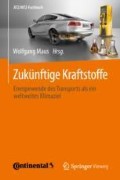Zusammenfassung
Oxymethylenether (OMEn; CH3(-OCH2-)nO-CH3, n = 3–5) stellen eine neuartige Klasse synthetischer Kraftstoffe dar, welche durch deren rußfreie Verbrennung steigendes Interesse erzeugen. In diesem Artikel wird eine neue wasserfreie OMEn Synthese vorgestellt. Bei 25–30 °C reagiert Dimethoxymethan (OME1) unter Anwesenheit katalytischer Mengen verschiedener Trimethyloxoniumsalze mit monomerem, gasförmigen Formaldehyd unter der Bildung reiner OMEn Mischungen. Dieser neuartige Ansatz zur Bildung von OMEn stellt einen vielversprechenden neuen Schritt zu einer nachhaltigen OMEn Synthese auf der Basis von CO2 und H2 dar.
Access this chapter
Tax calculation will be finalised at checkout
Purchases are for personal use only
Notes
- 1.
Prof. Dr.-Ing. J. Burger, „OME Technology made in Germany, 25.01.2017“, can be found under http://www.ome-technologies.de/fileadmin/omet/OMETechnologiesGmbH_Jan2017.pdf.
Literatur
Lumpp B, Rothe D, Pastötter C, Lämmermann R, Jacob E (2011) MTZ worldwide 72:34–38
Burger J, Hasse H (2013) Chem Eng Sci 99:118–126
Burger J, Siegert M, Ströfer E, Hasse H (2010) Fuel 89:3315–3319
Härtl M, Seidenspinner P, Jacob E, Wachtmeister G (2015) Fuel 153:328–335
Burger J, Ströfer E, Hasse H (2013) Chem Eng Res Des 91:2648–2662
Iannuzzi SE, Barro C, Boulouchos K, Burger J (2016) Fuel 167:49–59
Härtl M, Gaukel K, Pélerin D, Wachtmeister G, Jacob E (2017) MTZ worldwide 78:52–58
Niethammer B, Wodarz S, Betz M, Haltenort P, Oestreich D, Hackbarth K, Arnold U, Otto T, Sauer J (2018) Chem Ing Tech 90:99–112
Burger J, Papaioannou V, Gopinath S, Jackson G, Galindo A, Adjiman CS (2015) AIChE J 61:3249–3269
Burger J, Ströfer E, Hasse H (2012) Ind Eng Chem Res 51:12751–12761
Fang X, Chen J, Ye L, Lin H, Yuan Y (2015) Sci China Chem 58:131–138
Ouda M, Yarce G, White RJ, Hadrich M, Himmel D, Schaadt A, Klein H, Jacob E, Krossing I (2017) React Chem Eng 2:50–59
Schmitz N, Burger J, Hasse H (2015) Ind Eng Chem Res 54:12553–12560
Haltenort P, Hackbarth K, Oestreich D, Lautenschütz L, Arnold U, Sauer J (2018) Catal Commun 109:80–84
Wang L, Wu W-T, Chen T, Chen Q, He M-Y (2014) Chem Eng Commun 201:709–717
Wu J, Zhu H, Wu Z, Qin Z, Yan L, Du B, Fan W, Wang J (2015) Green Chem 17:2353–2357
Wu Q, Wang M, Hao Y, Li H, Zhao Y, Jiao Q (2014) Ind Eng Chem Res 53:16254–16260
Wu Y, Li Z, Xia C (2016) Ind Eng Chem Res 55:1859–1865
Zheng Y, Tang Q, Wang T, Liao Y, Wang J (2013) Chem Eng Technol 36:1951–1956
Himmel D, White RJ, Jacob E, Krossing I (2017) Sustain Energy Fuels 1:1177–1183
Reuss G, Disteldorf W, Gamer AO, Hilt A (Hrsg) (2012) Ullmann’s encyclopedia of industrial chemistry. Ch. Formaldehyde. Wiley-VCH & KGaA, Weinheim
Lide DR (2006) CRC handbook of chemistry and physics. A ready-reference book of chemical and physical data. CRC Press, Boca Raton
Preiss UPRM, Slattery JM, Krossing I (2009) Ind Eng Chem Res 48:2290–2296
Reedijk J, Poeppelmeier K (Hrsg) (2013) Comprehensive inorganic chemistry II. Elsevier, Oxford
Peter A, Fehr SM, Dybbert V, Himmel D, Lindner I, Jacob E, Ouda M, Schaadt A, White RJ, Scherer H et al (2018) Angew Chem Int Ed 57:9461–9464
Olah GA, Kiovsky TE (1968) J Am Chem Soc 90:4666–4672
Author information
Authors and Affiliations
Corresponding author
Editor information
Editors and Affiliations
Rights and permissions
Copyright information
© 2019 Springer-Verlag GmbH Deutschland, ein Teil von Springer Nature
About this chapter
Cite this chapter
Peter, A., Jacob, E., Krossing, I. (2019). Homogen katalysierte Synthese von Oxymethylenethern (OME) durch Aufnahme von molekularem Formaldehyd. In: Maus, W. (eds) Zukünftige Kraftstoffe. ATZ/MTZ-Fachbuch. Springer Vieweg, Berlin, Heidelberg. https://doi.org/10.1007/978-3-662-58006-6_16
Download citation
DOI: https://doi.org/10.1007/978-3-662-58006-6_16
Published:
Publisher Name: Springer Vieweg, Berlin, Heidelberg
Print ISBN: 978-3-662-58005-9
Online ISBN: 978-3-662-58006-6
eBook Packages: Computer Science and Engineering (German Language)

